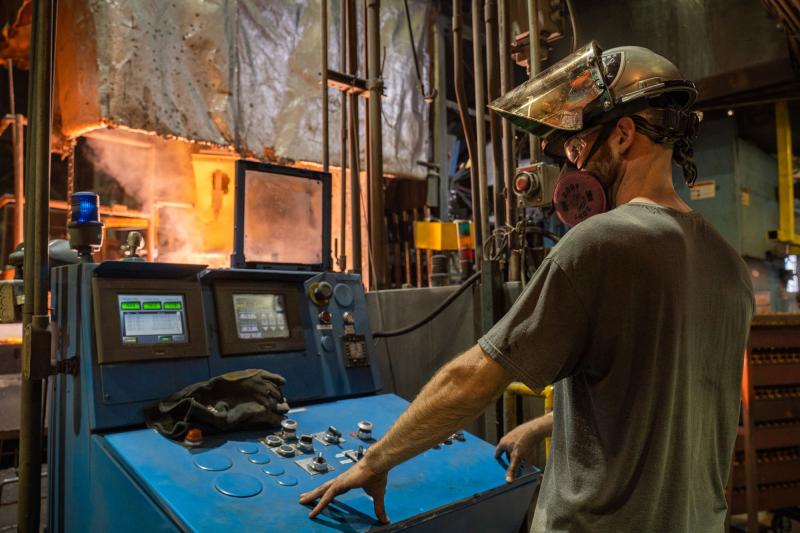If you were looking for a strong material for demanding industrial applications, why would you want to employ ductile cast iron? Properties like toughness, flexibility, and dependability might appeal to you, as well as its value — it can perform many of the jobs steel does at a more affordable rate (while also weighing less). From a broad perspective, that's a compelling combination. But let's delve deeper.
Testing the mechanical properties of ductile cast iron
If you're an engineer, you're more specifically concerned with the mechanical properties of ductile cast iron — or the ways the material responds as various forces are applied. Of particular interest are tensile strength (measured in megapascals or kips per square inch), yield strength (also measured in MPa or ksi), and elongation (as a percentage). These refer to how well a ductile iron casting resists breaking, bending, and pulling, respectively. Indentation hardness (as a Brinnell Hardness Number, or BHN) is also a critical consideration.
There are several standards of testing for ductile cast iron, most prominently those set forth by ASTM International (formerly the American Society for Testing and Materials) and SAE (Society of Automotive Engineers). These organizations separate ductile iron castings into grades based on mechanical performance in the areas described above, within predefined ranges.
Explaining the variances in ductile iron castings
Not all ductile iron castings are created equal. Yes, sometimes that's an issue of quality control. But more often, it's because a metallurgist is tweaking the chemical composition and certain process variables to achieve a very specific mechanical profile based on application.
As you may recall, cast iron is a class of iron-carbon-silicon alloys, often with trace amounts of other elements. Graphite carbon content is the main differentiator between cast irons (1.7 to 5 percent carbon) and steel (0.1 to 1.7 percent carbon). What distinguishes ductile cast iron vs. gray cast iron, however, is how that graphite carbon manifests — as flakes (in gray iron) or as spheroids (by introducing a nodulizing element such as magnesium, we get ductile iron). Going further, the different grades of ductile cast iron are produced by tinkering with crystalline microstructures on a molecular level, which have nuanced effects on the resulting ductile iron casting's mechanical properties.
Graphite nodularity percentage and graphite area percentage
When we discuss what ductile iron is and what makes it special, spheroidal graphite nodules are the key. This shape allows the graphite molecules to more readily slip past one another, resulting in a much more forgiving material than regular (gray) cast iron.
Graphite nodularity percentage is a measurement of how round the graphite nodules are — the higher it is, the more give the casting has when under tension. The unique mechanical properties of ductile cast iron attributable to nodular graphite are:
- Tensile strength
- Impact resistance
- Elasticity
- Elongation
Graphite area percentage refers to the ratio of graphite to iron matrices over the relative surface area of a polished face of iron. Relatively high carbon content is common to all cast irons, and contributes to:
- Compression strength (resistance to molecules being pushed together)
- Castability (ability to be easily poured into molds)
- Abrasion resistance (resistance to friction)
- Machinability (ability to be cut by machine tools)
- Fatigue strength (resilience over multiple load cycles)
- Positive strength to weight ratio
Iron Microstructures
As molten ductile iron is cooled, iron molecules may orient themselves into various microstructures depending on how rapidly we progress through various heat phases. These microstructures dictate how everything fits together — in particular, how the spheroidal graphite slots into the matrix.
Most grades of ductile cast iron exhibit some combination of ferrite and pearlite microstructures:
- A ferritic matrix contributes to impact resistance, elongation performance, and machinability, but is lacking in tensile strength, yield strength, and wear resistance.
- A pearlitic matrix contributes strength and hardness, but offers less ductility and impact resistance. Wear resistance is superior to pure ferrite, while machinability is comparable.
Specialized heat treatments such as austempering can produce other unique microstructures, such as ausferrite — a combination of acicular (needle-shaped) ferrite and austenite (iron in which carbon has been fully dissolved and infused). Austempered ductile iron (ADI), aka austenitic ductile iron, showcases properties such as enhanced strength, abrasion resistance, and toughness while sacrificing some ductility.
Consistent ductile iron castings from Urick
A consistent process means consistent castings, and consistent castings mean consistent customers. Urick Foundry is here to match your specifications and exceed your expectations, no matter what your engineering application.



